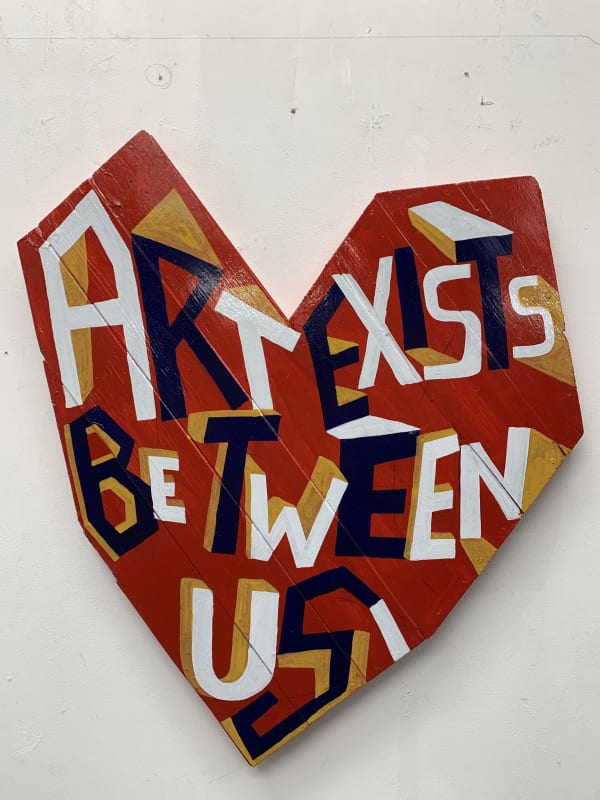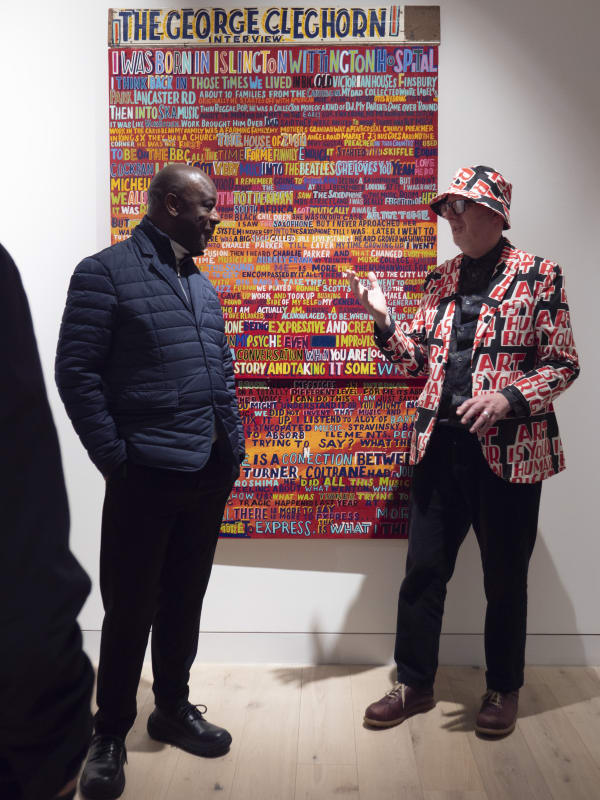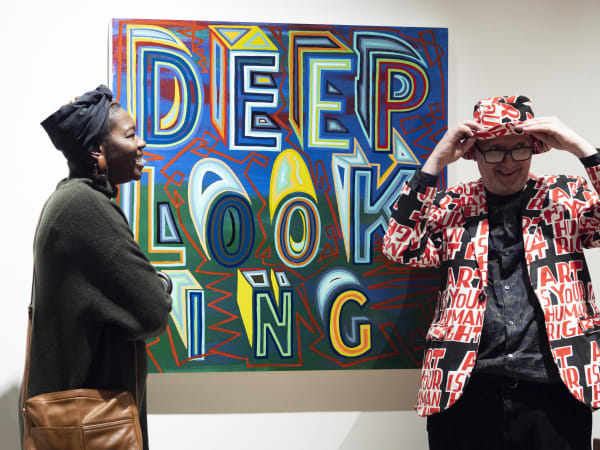BOB AND ROBERTA SMITH: ART IS LIKE LOVE: Solo show
-
 Bob and Roberta SmithART IS LIKE LOVE, 2023Sign writer's enamel on found timber70 x 60 cmSigned and dated verso
Bob and Roberta SmithART IS LIKE LOVE, 2023Sign writer's enamel on found timber70 x 60 cmSigned and dated verso -
 Bob and Roberta SmithArt is Like Love Art Exists between Us, 2023Sign writer's enamel on wooden panel40 x 50 x 5 cmSigned and dated verso£6,000.00
Bob and Roberta SmithArt is Like Love Art Exists between Us, 2023Sign writer's enamel on wooden panel40 x 50 x 5 cmSigned and dated verso£6,000.00 -
 Bob and Roberta SmithART EXISTS LIKE LOVE BETWEEN US ALL, 2023Sign writere's enamel on panel40 x 50 x 5 cmSigned and dated verso
Bob and Roberta SmithART EXISTS LIKE LOVE BETWEEN US ALL, 2023Sign writere's enamel on panel40 x 50 x 5 cmSigned and dated verso -
 Bob and Roberta SmithDeep Looking, 2023Sign writer's enamel paint on panel100 x 100 cmSigned and dated verso
Bob and Roberta SmithDeep Looking, 2023Sign writer's enamel paint on panel100 x 100 cmSigned and dated verso
-
 Bob and Roberta SmithJMW Turner, 2023Sign painter's enamel paint on wooden panel + vintage radiogram220 x 60 x 80 cmSinged and dated
Bob and Roberta SmithJMW Turner, 2023Sign painter's enamel paint on wooden panel + vintage radiogram220 x 60 x 80 cmSinged and dated -
 Bob and Roberta SmithPegwell Bay, 2023Oil paint on found timber60 x 80 cmSigned and dated verso
Bob and Roberta SmithPegwell Bay, 2023Oil paint on found timber60 x 80 cmSigned and dated verso -
 Bob and Roberta SmithART EXISTS BETWEEN US, 2023Sign writier's enamel paint on wooden panel70 x 60 cmSigned and dated verso
Bob and Roberta SmithART EXISTS BETWEEN US, 2023Sign writier's enamel paint on wooden panel70 x 60 cmSigned and dated verso -
 Bob and Roberta SmithART EXISTS LIKE LOVE BETWEEN US, 2023Sign writers enamel paint on wooden panel120 x 90 cmSigned and dated verso
Bob and Roberta SmithART EXISTS LIKE LOVE BETWEEN US, 2023Sign writers enamel paint on wooden panel120 x 90 cmSigned and dated verso
-
 Bob and Roberta SmithDIZZY GILLEPSIE , 2023100 x 100 cm + text painting 42 x 50 cmSigned and dated verso
Bob and Roberta SmithDIZZY GILLEPSIE , 2023100 x 100 cm + text painting 42 x 50 cmSigned and dated verso -
 Bob and Roberta SmithThe George Cleghorn Interview, 2023Sign writer's enamel paint on timber200 x 120 cmSigned and dated verso
Bob and Roberta SmithThe George Cleghorn Interview, 2023Sign writer's enamel paint on timber200 x 120 cmSigned and dated verso -
 Bob and Roberta SmithVan Gogh's View of Ramsgate, 2023Sign writers enamel paint on found timber100 x 100 cmSigned and dated verso
Bob and Roberta SmithVan Gogh's View of Ramsgate, 2023Sign writers enamel paint on found timber100 x 100 cmSigned and dated verso -
 Bob and Roberta SmithWE HAVE ONLY GOT EACH OTHER, 2023Sign writer's enamel on wooden panel70 x 60 cmSigned and dated verso
Bob and Roberta SmithWE HAVE ONLY GOT EACH OTHER, 2023Sign writer's enamel on wooden panel70 x 60 cmSigned and dated verso
-
 Bob and Roberta SmithAll Things Are Made, 2023Sign writer's enamel paint on placard22 x 30 x 4 cmSigned and dated
Bob and Roberta SmithAll Things Are Made, 2023Sign writer's enamel paint on placard22 x 30 x 4 cmSigned and dated -
 Bob and Roberta SmithLeslie Butterworth, 2016Sign painter's enamel on wooden panels + vintage radio220 x 40 x 40 cmSigned
Bob and Roberta SmithLeslie Butterworth, 2016Sign painter's enamel on wooden panels + vintage radio220 x 40 x 40 cmSigned -
 Bob and Roberta SmithMake Art Not War (in Russian), 2023Sign painter's enamel paint on wooden panel30 x 30 x 5 cmSigned and dated
Bob and Roberta SmithMake Art Not War (in Russian), 2023Sign painter's enamel paint on wooden panel30 x 30 x 5 cmSigned and dated -
 Bob and Roberta SmithMake Art Not War - What Does Peace Mean To You?, 2019Sign painter's enamel paint on wooden panel + objects attached120 x 120 x 1 0cmSigned and dated
Bob and Roberta SmithMake Art Not War - What Does Peace Mean To You?, 2019Sign painter's enamel paint on wooden panel + objects attached120 x 120 x 1 0cmSigned and dated
-
 Bob and Roberta SmithSir Joshua Reynolds, 2016Sign painter's enamel paint on wooden panels + tin vase = wooden stool at base160 x 40 x 40 cmSigned
Bob and Roberta SmithSir Joshua Reynolds, 2016Sign painter's enamel paint on wooden panels + tin vase = wooden stool at base160 x 40 x 40 cmSigned -
 Bob and Roberta SmithTeaching Is Beautiful, 2023Sign writer's enamel paint on wooden panel30 x 30 x 5 cmSigned and dated
Bob and Roberta SmithTeaching Is Beautiful, 2023Sign writer's enamel paint on wooden panel30 x 30 x 5 cmSigned and dated -
 Bob and Roberta SmithThere Is Still Art There Is Still Hope, 2023Sign writer's enamel paint on placard30 x 30 x 4 cmSigned and dated
Bob and Roberta SmithThere Is Still Art There Is Still Hope, 2023Sign writer's enamel paint on placard30 x 30 x 4 cmSigned and dated -
 Bob and Roberta SmithTom Hudson, 2016Sign painter's enamel paint on wooden panels160 x 40 x 30 cmSigned
Bob and Roberta SmithTom Hudson, 2016Sign painter's enamel paint on wooden panels160 x 40 x 30 cmSigned
-
 Bob and Roberta SmithTurner, 2023Sign painter's enamel paint on wooden panels220 c 60 c 80 cmSigned
Bob and Roberta SmithTurner, 2023Sign painter's enamel paint on wooden panels220 c 60 c 80 cmSigned -
 Bob and Roberta SmithWe Are Going To Make The World A Better Place, 2023Sign writer's enamel paint on wooden panel30 x 30 x 5 cmSigned and dated verso£3,000.00
Bob and Roberta SmithWe Are Going To Make The World A Better Place, 2023Sign writer's enamel paint on wooden panel30 x 30 x 5 cmSigned and dated verso£3,000.00 -
 Bob and Roberta SmithWhat Unites Human Beings, 2023Sign writer's enamel paint on wooden panel30 x 30 x 5 cmSigned and datedSold
Bob and Roberta SmithWhat Unites Human Beings, 2023Sign writer's enamel paint on wooden panel30 x 30 x 5 cmSigned and datedSold -
 Bob and Roberta Smith , Everything Is Made, 2023
Bob and Roberta Smith , Everything Is Made, 2023
ART IS LIKE LOVE
ART EXISTS BETWEEN US
ART IS LIKE LOVE
A solo exhibition of recent works by Bob and Roberta Smith RA, OBE.
7 February - 28 March 2024.
Bob and Roberta Smith, AKA Patrick Brill, is a prominent British contemporary artist, activist, writer, broadcaster, musician, and advocate for art education. A Royal Academician and awarded the OBE in 2017 for his services to Art, Smith's extensive engagement in the art elite converges seamlessly with his active involvement in political discourse. Serving as a fervent proponent of arts education, Smith's practice extends to a diverse array of mediums, including film, radio, documentary, writing, and music. As the frontman of The Apathy Band, a collective featuring his wife, artist Jessica Voorsanger, Smith leads an innovative and experimental spoken word ensemble.
One of Smith's remarkable projects was the Thamesmead Codex, commissioned by Tate and the Peabody Trust. This initiative involved translating the stories of Thamesmead residents into painted placards, effectively amplifying the voices of marginalised communities and underscoring their desire to be heard. Currently showcased at Tate Modern until May 2024, the Thamesmead Codex serves as a testament to Smith's commitment to inclusivity and narrative storytelling.
"ART IS LIKE LOVE" is a testament to the enduring connection between art and emotion. Bob and Roberta Smith's unique artistic vision reimagines the personality of JMW Turner and delves into the fascinating world of other captivating figures. Through a curated selection of paintings and sculptures, the exhibition promises a journey through the artist's profound exploration of creativity and love.
Featuring is Bob and Roberta Smith’s new sculpture of JMW Turner upon which is written a text that questions popular perceptions of the artist and seeks to assert a view of Turner as a radical and political figure.Turner had a vision of the arts that was far in advance of his peers. Turner painted the news. Creating images not only of wars, technological advance, and Parliament in flames. He saw art as a kind of moral and political research, promoting at the end of his life the Abolition of slavery. Bob and Roberta Smith think that Turner embarked on a journey that was not unique in Victorian England, from lack of empathy with enslaved Africans to campaigning for their freedom. For this reason, Bob thinks Tate should be renamed ‘Turner’. Torestatehowthroughartwecanunderstandtheworldbetter.
Before Covid 19,Petworth House National Trust had commissioned Bob and Roberta Smith to realise a work relating to Turner. Sadly, the project was cancelled due to Covid, but now for the first time we are presenting a painting ‘The George Cleghorn Interview’ which comprises a collaboration between the renowned saxophonist and Bob and Roberta inspired by JMW Turner. In this work Cleghorn compares Turner’s depiction of light at Petworth with John Coltrane’s polyphonic soundscapes such as ‘A Love Supreme’. Cleghorn, the son of a Windrush generation migrant to the UK, also explains his inspiring and enriching journey to discover the saxophone.
The title and overarching message encapsulated in the slogan "ART IS LIKE LOVE" includes romantic and friendship bonds but also extends beyond them. It symbolises a profound and expansive love that encompasses responsibility for what is entrusted to you and care for your environment, in the most personal way.
The slogan "ART IS LIKE LOVE" is presented as a seemingly simple statement, but its significance lies in prompting the audience to contemplate the profound dimensions of its meaning. In a world marked by pervasive violence and where warfare is a recurrent and almost mundane feature of the news, the essential missing element is identified as love. The idea conveyed is that if individuals can embrace a genuine love for their neighbours, extending beyond borders, transcending racial and religious differences, it can serve as a unifying force. This perspective suggests that fostering love can eliminate divisions among people, emphasising our shared humanity. The notion is that if individuals genuinely love and respect one another, acts of violence and harm would be mitigated because harming another would be tantamount to harming oneself—a recognition of the interconnectedness of humanity.
The connection between art and love is then explored, asserting that art, despite potentially depicting violent imagery, is fundamentally peaceful and anti-war. Even when art portrays scenes of conflict or violence, it is argued that the intention is often to criticise or reflect on the harsh realities rather than to glorify them. The statement recognises that artists who use their work as a form of protest against oppressive regimes or totalitarian governments may face imprisonment, highlighting the power of art to challenge authority and advocate for peace. In essence, the expanded interpretation of the slogan underscores the potential for art and love to act as transformative forces in a world plagued by violence and division, promoting unity, understanding, and a shared commitment to peace.
A heart filled with love becomes incapable of cruelty, destructiveness and divisiveness. The brokenness of the world, deprived of love - our intrinsic expansive nature - can be restored through Art which like Love is the unifying glue. Art reinforces love like gold in the Japanese Kintsugi technique for repairing broken porcelain. The rallying cry "ART IS LIKE LOVE BETWEEN US ALL" resounds with Smith's mission to champion arts education and inclusivity, underscoring the profound impact that love and creativity can have on the world.
Notably, Smith is an associate professor at the School of Art, Architecture, and Design at London Metropolitan University.








































